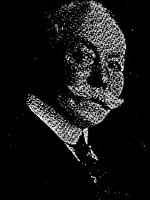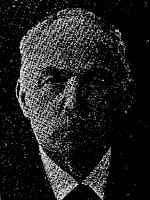
|

|
Wilhelm Fantl
from Èimelice
Ed. Kohn
from Mirovice
|
|
[Pages 403-404]
(Mirovice, Czech Republic – 49°31' 14°02')
(Mirotice, Czech Republic – 49°26' 14°02')
Compiled by Jaroslav Pola´k-Rokycana, Prague
Translated from the original German and Czech by Jan O. Hellmann/DK
Edited in English by Rob Pearman/UK
Mirovice
In earlier times, Mirovice was a flourishing rural Jewish community. Today, the abandoned synagogue is a unique building that is destined to die. The internal arrangement is very beautiful. The lectern is not on the east side, but in the middle of the prayer hall. The women's part is in a neighbouring room that is linked to the men's area by an arched window. Only on High Holydays is it possible to raise a minyan[1].
The chairman of this community is Wilhelm Fantl, a merchant from Čimelice[2]. The record keeper is Bedøich Steiner, a merchant from Mirovice. The community's cemetery is in the nearby village of Myslín, nicely situated on the east side of a hill and surrounded by a massive wall. The oldest grave stones are perhaps from the 16th century, but they are buried by high grass and bushes. There are still occasional burials in the upper part of the cemetery for those who have died in the nearby villages.
|
|
|||
Wilhelm Fantl from Èimelice |
Ed. Kohn from Mirovice |
Mirotice
The Jewish community of Mirotice is 250 years old. The oldest legible grave stone is marked with number úå = 470 = 1647[3]. The inscription is simple. “Here rests Mrs. Hendl, daughter of Mr. Läml from Sedlice. She died on 8th Tebet 5407”[4]. The Lämls are a well known family from Prague.
The Jewish community does not possess the oldest document concerning the purchase of a plot of land for the cemetery. The only document that has been preserved is a further contract issued by Jan Winkler, a citizen of Mirovice, in which he confirms the sale of land for the indicated price of 340 guilders. The Jewish community commits themselves to pay 40 pennies[5] to the town of Mirovice for the burial of each adult and 20 pennies for each child. For the burial of persons from out-of-town, a charge of 48 pennies is to be paid. The Jews have the right to build a wall around the cemetery and the purchase is to be recorded in the land registration book.
*
Löbl Kafka – written in the Czech records as “Kawka” - was the son of Markus Kafka (in Hebrew אטיד) and he gave great service to the town of Písek in 1621. This resulted in the fact that Jews previously from Boleslav[6] became protected Jews in the town of Písek. The Steward at that time was J. M. Angermann. He made a record of this on 6 April 1691 and it was confirmed by the Royal Steward of the Prachyò region, Zikmund Ludvík Traumansdorf. This record confirms that the “Jew Löbl Kafka” went to Augermann and informed him discreetly that he had heard about a planned rebellion among the soldiers. The rebellion could therefore be prevented and some of the plotters were hanged. For this demonstrable loyalty Kafka and his future family became protected Jews in Písek.
With regards to the Jewish history of Mirotice, mention should also be made of the case between the Jew Mandl Pržckel from Vodòany and the knight František Wolf from Bĕšín (1648). This knight imprisoned the Jew Mandl but released him again “because, in this restless time and during a period of military activity, justice cannot be done”. The process dragged on for several years and finally the Jew was found innocent “as he spoke truly”.
|
|
Rabbi's house and Cheder |
In 1661 there was one Jewish house in Mirovice.
Jews were present in Kestřany and Kožele[7] from 1648-1670, and this proves that Jews lived in the Písek and Práchyò region from earlier times. In spite of the fact that Jews were not liked, we can see from the town records that the citizens of Písek were concerned that even Jews should be treated justly and should be able to carry out their business in peace.
*
|
|
Jewish school and Temple/Synagogue |
All the information included in this article was provided by the former chairman of the Jewish community of Mirotice, Dr. M. Grünwald. The oldest Jewish family in Mirotice is that of Leopold Bloch. The Mirotice community is in reality the maternal community of the Písek community, as almost all Písek Jews found their final resting place in the Mirovice cemetery.
It has not been possible to read the grave stones owing to their eroded condition.
Links
Jewish cemetery in Mirotice in Czech with photos: http://smetanova.lhota1.sweb.cz/mirjewc.htmlA plaque in the castle at Mirotice indicates that General Vlasov, the Russian army leader who defected to fight alongside the German army after his capture by them in 1942, was executed by the Red Army in this town after the liberation. Other sources claim that he was executed in Moscow in 1946, having been handed over to the Soviet government, together with many other Russian collaborators, by the American and British authorities.
History of Mirotice in English: http://smetanova.lhota1.sweb.cz/miroticengl.html
Photos from Jewish cemetery in Mirovice: http://commons.wikimedia.org/wiki/Category:Jewish_cemetery_in_Mirovice
Short history of Mirovice in Czech: http://www.mirovice-mesto.cz/mirovice-dalsi-zajimavosti/d-6275/p1=27152
Footnotes
|
|
JewishGen, Inc. makes no representations regarding the accuracy of
the translation. The reader may wish to refer to the original material
for verification.
JewishGen is not responsible for inaccuracies or omissions in the original work and cannot rewrite or edit the text to correct inaccuracies and/or omissions.
Our mission is to produce a translation of the original work and we cannot verify the accuracy of statements or alter facts cited.
 Jews and Jewish Communities of Bohemia in the past & present
Jews and Jewish Communities of Bohemia in the past & present
 Yizkor Book Project
Yizkor Book Project
 JewishGen Home Page
JewishGen Home Page
Copyright © 1999-2024 by JewishGen, Inc.
Updated 19 Mar 2021 by LA